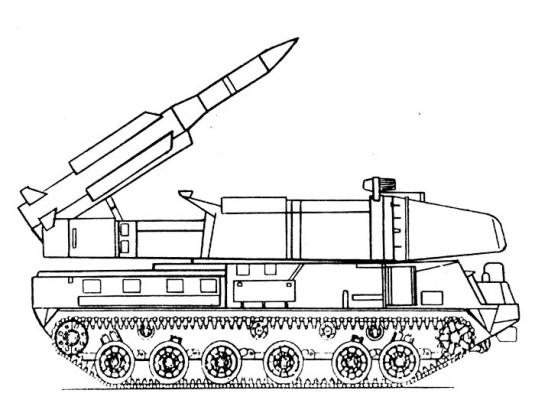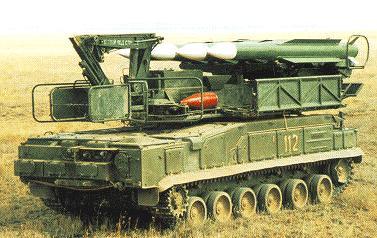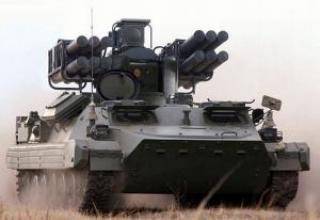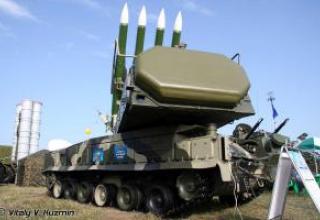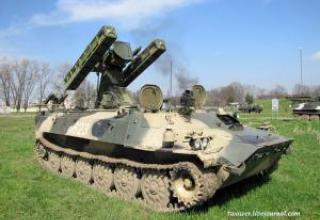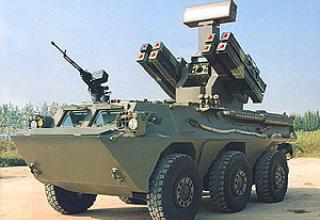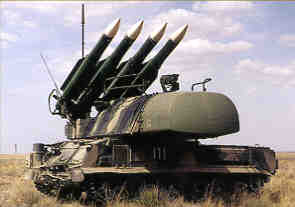
The development of the complex "Beech" was started by the Decree of the CPSU Central Committee and the USSR CM of January 13, 1972 and provided for the use of cooperation between designers and manufacturers, the basic composition of the corresponding previously involved in the creation of SAM "Cube". At the same time, the development of the M-22 "Hurricane" SAM system for the Navy was determined using a single SAM system with the "Beech" complex.
The military SAM system "Buk" was designed to fight in the conditions of radio resistance with aerodynamic targets flying at speeds up to 830 m / s, at medium and low altitudes, maneuvering with overloads to 10-12 units at ranges up to 30 km, and in the future - and with ballistic missiles "Lance".
Developers of a complex and its systems
The developer of the "Buk" SAM was determined to be the Scientific Research Institute of Instrument Engineering (General Director V.K. Grishin). A.A.Rastov was appointed as the Chief Designer of 9K37 complex as a whole, G.N.Valayev (then - V.I.Sokiran) was appointed as the Command Post (CP) of 9C470, 9A38 - V.V.Matyashev was appointed as the Self-propelled Firing Units (SAU), I.G.Hakobyan was appointed as the Semi Active Doppler Homing Head 9E50 for SAU.
The 9A39 ROM launchers were created at the Machine Building Design Bureau (MDC) "Start" under the leadership of A.I.Yaskin. Unified tracked chassis for complex combat vehicles were created at the Design Bureau-40 of Mytishchi Machine Building Plant by a team headed by N.A.Astrov. The Sverdlovsk Machine Building Design Bureau "Novator" headed by L.V.Lyuliev was entrusted with the development of 9M38 missiles. The 9C18 detection and target designation station (SOC) ("Dome") was developed at the Measuring Instruments Research Institute under the supervision of Chief Designer A.P.Vetoshko (later - Yu. P.Shchekotov).
In the west, the complex was designated SA-11 "Gadfly".
Composition:
The composition of the "Buk" SAM system includes the following combat vehicles:
- ZUR 9M38;
- Command post 9C470;
- 9C18 "Dome" detection and target designation station;
- 9A310 self-propelled fire station;
- Starting and charging unit 9A39.
ZUR 9M38
Anti-aircraft missile 9M38 is made with the use of dual-mode solid propellant engine (total operating time - about 15 seconds), according to the normal aerodynamic scheme with the "X" - placement of wings of small elongation.
In the front part of the rocket are sequentially placed semi-active homing head, autopilot equipment, power supplies and combat unit. To reduce the spread of alignment over the flight time, the combustion chamber of the RDTT is placed closer to the middle of the missile and the nozzle block includes an elongated gas stroke, around which there are elements of the steering gear. The rocket has no detachable parts in flight. A new CPS with combined control system has been developed for the missile. The complex was implemented self-guided LSD using the method of proportional navigation. The combat unit is of shrapnel-phase type.
Command post 9C470
Located on the GM-579 chassis, the 9C470 command post provided:
- Receiving, displaying and processing target information from the 9C18 detection and target designation station and six self-propelled firing systems, as well as from superior control points;
- selection of dangerous targets and their distribution among self-propelled fire-fighting units in manual and automatic modes, setting of their sectors of responsibility, displaying of information on the availability of SAMs on them and on the charging units, on the transmitters lit by self-propelled fire-fighting units, on their operation according to targets, on the operation modes of the detection and target designation station;
- organization of the complex's operation under conditions of interferences and application of anti-radar missiles by the enemy;
- documentation of the work and training of the control calculation.
The command post processed reports of 46 targets at altitudes up to 20 km in a 100 km radius area and issued to self-propelled fire stations up to 6 targets with an accuracy of 1° on azimuth and angle of position, 400-700 m - on range.
The weight of the control unit with the combat calculation of 6 persons did not exceed 28 tonnes.
9C18 ("Dome") detection and target designation station.
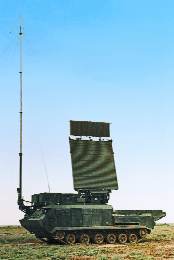
Three-axis coherent-pulse 9C18 detection and target station ("Dome") of centimeter range with electronic scanning of the beam in the sector by the angle of place (set at 30° or 40°) and mechanical (circular or in a given sector) rotation of the antenna by azimuth (by means of electric or hydraulic drive) was designed for detection and identification of air targets at ranges up to 110-60 mm. 120 km (45 km with a flight altitude of 30 m) and air traffic information transmission to KP 9C470.
Space visibility rates, depending on the sector, were between 4.5 and 18 seconds for all-round visibility and between 2.5 and 4.5 seconds for 30° visibility. Radar information was transmitted via a telescode line at KP 9C470, with 75 markings during the survey period (4.5 s). Mean-square errors (RMS) of target coordinates measurements were: no more than 20' - in azimuth and angle of position, no more than 130m - in range, resolution in range not worse than 300m, in azimuth and angle of position - 4°.
For protection against sighting interferences the rearrangement of the carrier frequency from impulse to impulse was used, from reciprocal - the same as blanking of range intervals on the autosurvey channel, from non-synchronous impulses - change of slope of linear-frequency modulation and blanking of range sections. At noise barriers of self-coverage and external cover of the specified levels, the detection and target designation station provided detection of a fighter aircraft at a range of at least 50 km. The station provided target guidance with a probability of no less than 0.5 on the background of local objects and in passive interferences by means of a scheme of selection of moving targets with autocompensation of wind speed. The station was protected from anti-radar missiles by means of program reconstruction of the carrier frequency in 1.3 s, transition to circular polarization of the probing signals or to intermittent radiation (flickering) mode.
The station consisted of an antenna post consisting of a truncated parabolic reflector, an irradiator in the form of a full-flowing ruler providing electronic scanning of the beam in the angular plane, a rotating device, a device for folding the antenna into a camping position; a transmitting device (with an average power up to 3.5 kW); a receiving device (with a noise coefficient not exceeding 8) and other systems.
Time of transfer of the station from marching to combat position was not more than 5 minutes, and from duty to operational - not more than 20 seconds. The weight of the station with the calculation of 3 people - no more than 28.5 tons.
9A310 self-propelled fire machine
The time of transfer from camping to combat was no more than 5 minutes. The time of transfer from duty to operational mode, in particular, after changing the position with the equipment on was no more than 20 seconds. Charging of the 9A310 self-propelled fire engine with four ZUR from the starting and charging unit took 12 minutes, and from the transport vehicle - 16 minutes.
The weight of the 4-person self-propelled gun did not exceed 32.4 tons. The length of the self-propelled firing unit was 9.3 m, width -3.25 m (9.03 m in working position), height - 3.8 m (7.72 m).
Start Charging Unit 9A39
The 9A39 starter-charging unit located on the GM-577 chassis was designed for transportation and storage of eight ZURs (4 each on the starting device and fixed belts), starting of 4 ZURs, self-loading of its starting device with four ZURs from belts, self-loading of eight ZURs from the transport vehicle (for 26 minutes), with ground belts and from transport containers, charging and discharging of a self-propelled fire unit with four ZURs. In addition to the starting and charging unit with a power tracking drive, the crane and trapezers included a digital computer, navigation, top linking and orientation equipment, telecode communication, power supply and power supply units. The weight of the unit with the combat calculation of 3 people - not more than 35.5 tons.
The length of the starting and charging unit was 9.96 m, width - 3.316 m and height - 3.8 m.
Characteristics:
| Defeat zone, km: - at a distance - in height - as defined in |
3,5..25-30 0,025..18-20 till 18 |
| Probability of hitting the target of one SSD - like a fighter jet - helicopter type - cruise missile type |
0,8..0,9 0,3..0,6 0,25..0,5 |
| Maximum target speed m/s | 800 |
| Response time, s: | 22 |
| ZUR flight speed, m/s | 850 |
| Mass of the rocket, kg | 685 |
| Weight of combat unit, kg | 70 |
| The length of the rocket, m | 5.55 |
| Hull diameter, m | 0.4 |
| Start weight,kg | 685 |
| Weight BC, kg; | 70 |
| Target channeling | 2 |
| Zurich canalization | 3 |
| Deployment time (closures), mines | 5 |
| The number of SSDs on a combat vehicle | 4 |
Testing:
Joint testing of the complex "Buk" in the full set of funds were carried out from November 1977 to March 1979 at the Emba range (range manager V.V. Zubarev) under the guidance of a commission headed by Yu.
The command post of the complex received from the control of the anti-aircraft missile 6pigadas "Buk" (ACS "Polyana-D4") and from the detection and target designation station information about the air situation, processed it and issued to the self-propelled firing systems, which carried out search and seizure of targets on auto tracking. When a target entered the area of engagement, the SUR was launched. Missiles were guided by the method of proportional navigation, which provides high accuracy of pointing at the target. When approaching the target, the CNS issued a command to the radio detonator for close approach. When approaching the target at a distance of 17 m on command detonated combat unit. When the radio detonator failed to operate, the ZUR self-destructed. When the target was not hit, the second SAM was launched.
Compared to the previous systems of similar purpose ("Cube-M3" and "Cube-M4" SAMs), the "Buk" complex had higher combat and operational characteristics and provided:
- simultaneous firing of up to six targets by the division, and, if necessary, the performance of up to six independent combat tasks with self-propelled guns;
- greater reliability in detecting targets by providing a joint space overview by a detection and target designation station and six self-propelled guns;
- increased noise immunity due to the use of onboard CNS computer and a special type of backlighting signal;
- greater target acquisition efficiency due to the increased power of the combat unit of the SAM system.
Based on the results of firing tests and simulations, it was determined that the Buk SAM system provides for firing of non-manoeuvring targets flying at a speed of up to 800 m/s at altitudes from 25 m to 18 km, at ranges from 3 to 25 km (up to 30 km at target speed of up to 300 m/s) at a heading parameter of up to 18 km with a probability of hitting one SAM equal to 0.7-0.8. When shooting at targets maneuvering with overloads up to 8 units, the probability of engagement decreased to 0.6.
Buk" SAMs were organizationally reduced to anti-aircraft missile brigades, which included: Control (a point of combat control of the brigade from the ASU "Polyana-D4"), four anti-aircraft missile division with its own control 9C470, a detection and target designation station 9C18, communications platoon and three anti-aircraft missile batteries with two self-propelled firing 9A310 and one 9A39 launcher in each, as well as maintenance and service divisions.
The Buk anti-aircraft missile brigade was to be operated from the army's air defense command.
The "Buk" complex was adopted for service with the Army Air Defense Forces in 1980.
Sources:
- Зенитные ракетные комплексы ПВО СВ. Техника и вооружения №5-6.99
- "Невский Бастион" N1 1997, выпуск 2
- Вестник ПВО
- Russian Missile Systems - www.wonderland.org.nz

